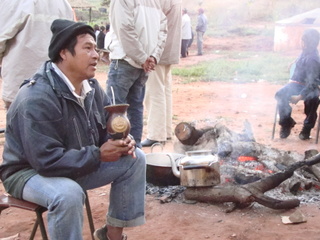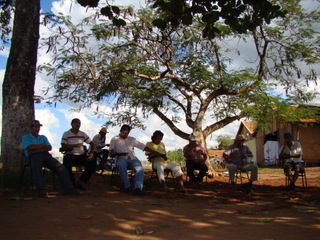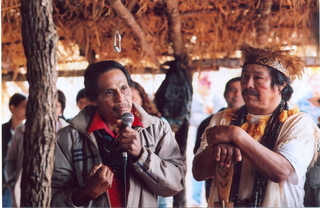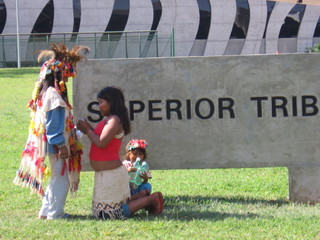The dilemma of the frontiers for the Guarani
Interview with professor Antonio Brand, of the Catholic University of Dom Bosco, Dourados, Mato Grosso do Sul (Brazil)
"Guarani identity remits directly to the idea of belonging and to the kinship relations. Hence the importance of the conception of territory as a space of communication, with its reference points and updating by memory",  says Antonio Brand. In this sense, he explains, national borders represent a problem for the Guarani because "they hinder this communication". Independent of the territorial division, they "follow their own notions and concepts of frontier, an idea more sociological and ideological, which includes, excludes and defines who belongs and who does not belong to a given collectivity."
says Antonio Brand. In this sense, he explains, national borders represent a problem for the Guarani because "they hinder this communication". Independent of the territorial division, they "follow their own notions and concepts of frontier, an idea more sociological and ideological, which includes, excludes and defines who belongs and who does not belong to a given collectivity."
by Instituto Humanitas Unisinos – click here for Original text –
Antonio Brand has degrees in History from the University of Vale do Rio dos Sinos – Unisinos, masters and doctorate in history from the Catholic University of Rio Grande do Sul – PUCRS. His thesis is entitled "The impact of land loss on the Kaiowá/Guarani tradition: the difficult path of the Word." He is currently a professor in the Masters and PhD Programs in Education and Local Development at the Catholic University Dom Bosco, MS.
Check out the interview.
.
IHU On-Line – What is the impact of national borders in the history of the Guarani people?
Antonio Brand – Initially, the formation of Nation States in the early nineteenth century, or the definition of national boundaries, which crossed the Guarani territory, did not lead to major consequences for the Guarani, in that the effective occupation of the region by non-indigenous fronts happened considerably later. When I speak of Guarani, I refer to diverse groups recognized by anthropology as Guarani, especially the Mbya, Ñandeva or Ava, which in Brazil are the only ones recognized as Guarani and the Kaiowá or Paí-Tavyterã in Paraguay. I will use, normally, the Guarani term in reference to them all or else the Guarani autodenomination to refer only to the Ñandeva, who along with the Kaiowá are present in Mato Grosso do Sul
In both Paraguay and Brazil, in the late nineteenth century, large companies were established to exploit natural resources (wood and yerba mate), in the large Guarani territory. These companies do not have direct interests in land ownership, but in natural resources. Therefore, the consequences of that presence to the Guarani were relatively minor than the fronts that were later installed in the same indigenous territory and that are disputed with the Guarani for land tenure. Despite the possible exploitation of indigenous labor and of their contributing to the increase of old and new diseases, which cause great impact on the indigenous population (measles, smallpox, tuberculosis, among others), the presence of these companies is indicated by various researchers as a factor in the seclusion of much of that same territory, by preventing the installation of settlers or colonization projects, which would put their monopoly at risk. And also for not having an explicit "civilizing project". By preventing the installation of this type of development they actually contributed to the preservation of the indigenous territory. Therefore, indigenous communities in this region of the border succeeded in maintaining relative economic and cultural autonomy in Brazil until approximately the 1950s and in Paraguay until the 1970s. In Argentina, this autonomy continues until more recently when deforestation of indigenous lands intensifies. It is also a period in which the Guarani disappear from the national scenarios."
Borders impact Guarani lives
In Paraguay, following the extinction of what remained of the "Pueblos de Indios" in the government of Carlos Antonio Lopez, in 1848, the fate of the Guarani caaguá (or Monteses- People of the mountains), who lived in the forests, would be decided in the restricted context of the internal expansion fronts of each country. They are relegated to the margins of development processes that are implanted in each country, being considered only as possible labor force and/or nuisance to be eliminated by these same expansion fronts.
It is a period of terrible violence, as evidenced by the documentation, a consequence of the omission by the new States, which in the occupation of their territorial spaces and the quest for economic integration, especially in the early twentieth century, ignore and omit indigenous rights to land in spite of incipient legislation that emerges, slowly, since the early twentieth century, seeking to guarantee these rights. We should remember, in Brazil, the creation of the Service for Protection of the Indian – SPI in 1910.
Therefore, with regard to this issue of borders and their impact on the Guarani, there are a few highlights:
.
– The Treaty of Madrid, which basically defines today’s borders, did not lead to immediate consequences for the Guarani. National borders begin to constitute a problem for them only to the extent to which they are occupied by non-indigenous people. And despite the common characteristics indicated above, the processes of colonization are different in each country, in particular in reference to the intensity and rapidity of this occupation. In this sense, in relation to the Brazil/Paraguay border, the occupation is first and most intensively on the Brazilian side, which is why the situation of Guarani confinement on this side is more radical than in other countries;
– The Guarani have been ignored by governments and economic development programs implemented in these regions. Very recently, and in the measure to which they create problems for territorial occupation, governments of each country came to occupy these. In Brazil, from 1915, the SPI demarcated land reserves for the usufruct of the Guarani, located in what is now Mato Grosso do Sul. In Paraguay, this process takes place in the 1970s and in Argentina, I believe it is even more recent. However, to the extent that governments define their indigenous policies, trying to meet different demands and economic interests, the Guarani are facing, also, distinct problems on each side of the border.
IHU On-Line – Which Guarani groups live on the borders of countries in Latin America? What are their characteristics?
Antonio Brand – The Guarani and Guarani-speaking populations in the sixteenth century occupied a vast territory in the lowlands of South America, extending from the coast of Santa Catarina, along the Paraguai, Apa, Miranda and Pilcomayo rivers, to the foothills of the Andes.
Today they are found in Bolivia, Paraguay, Uruguay, Brazil and Argentina, this language in its several varieties of dialect, being the one spoken in all these countries. In this sense, we can consider the Guarani language as "historical language" of Mercosul.
The Guarani with whom we have greatest contact belong to the Ñandeva linguistic groups (the only ones who call themselves Guarani), Kaiowá and Mbyá, who are in the border region between Brazil, Paraguay and Argentina. In Bolivia, Argentina and Paraguay also find the Guarani-Chiriguano who also assume diverse denominations.
In the past year, under the auspices of a project focusing on public policy common to the Guarani in Mercosul, we organized a trip for one delegation of Guarani representatives from Brazil Paraguay and Argentina, during which, for ten days, they visited villages located along the borders of these countries. During the trip it was possible to confirm that for the Guarani, following national boundaries made no sense, though they increasingly realize that hindrance to their circulation across borders.
They have relatives in different countries and continue to visit regularly. Moreover, all participants of the trip were treated like family. According Melià, the Guarani are following their own notions and concepts of frontier, an idea more sociological and ideological, which includes, excludes and defines who belongs and who does not belong to a certain collectivity, establishing the limits for those for whom they do not feel "in keeping with". The same investigator, referring to the Guarani concept of territory, speaks of "the territory of communication", full of landmarks, roads, homes, resources and occurrences (Melia, 2007)."
Characteristics
The Guarani, traditionally, occupied their vast territory, according to the availability of locations with natural resources considered appropriate – preferring to establish their villages in areas of forest and near good water courses. In addition to this, it would be a place free from supernatural threats and diseases – researching the recent history of the Guarani it can be seen that several villages have been abandoned by them due to illness – and near allied families.
 They distribute themselves in small nuclei, consisting of one or more family groups, under the leadership of the ñanderu or tekoaruvicha, leaders of a distinctly religious character, whose power was supported by the prestige due to kinship, ability to persuade and their generosity and not by force or physical ability.
They distribute themselves in small nuclei, consisting of one or more family groups, under the leadership of the ñanderu or tekoaruvicha, leaders of a distinctly religious character, whose power was supported by the prestige due to kinship, ability to persuade and their generosity and not by force or physical ability.
Guarani identity remits directly to the idea of belonging and to kinship relations. Hence the importance of the concept of territory as a space of communication, with its reference points and updating through memory. Therefore, national borders are a problem for the Guarani in so far as they hinder such communication.
IHU On-Line – What are the implications of the loss of land to Kaiowa/Guarani communities, in particular as refers to the tradition of people who seek the land without evil?
Antonio Brand – The historical process of territorial reduction and confinement within small areas of land reserved for Guarani and Kaiowá in Brazil has generated innumerable changes in their daily lives, in particular, having created new challenges for their social organization and is targeted by researchers and indigenous representatives as a cause of many problems currently experienced by this population. The confinement and overcrowding within the demarcated reserves reduced the space available, causing the depletion of natural resources important to the quality of life in a Kaiowa and Guarani village and hampered food production. This transformed peoples who for centuries have produced not only sufficient, but plentiful food, as evidenced by the historical documentation, into depending on the distribution of welfare food baskets and all kinds of outside assistance. Peoples who were important labor and contributed to the establishment of a large part of agro-livestock and public enterprises, such as railroads and highways in Mato Grosso do Sul, today can no longer provide a livelihood for themselves and their children.
 But beyond the consequences for the indigenous economy, this process of confinement has created problems for their social organization. As stated above, scattered in small, autonomous macro-familial nuclei, under the authority of elders, ñanderu or tekoaruvicha. When the situation in a given space, for various reasons, becomes inadequate, they seek out other places within this large territory. New villages are formed. The process of confinement forced these nuclei to seek shelter in reserves demarcated by the SPI, which, to manage these "gatherings" of Indians and villages, created the figure of the ‘captains’, indigenous leaders more familiar with the Western way of life, arbitrarily nominated as top leaders in the reserves. And to help them to exercise power and maintain order, over those who had no power, the Indian police were also established. Insofar as the traditional indigenous territory was being occupied by various fronts of exploration, the macro-familial groups were being forced to move into stocks and thus, in addition to live and play lots increasingly smaller groups with other macro family had to submit to the authority of foreign leaders.
But beyond the consequences for the indigenous economy, this process of confinement has created problems for their social organization. As stated above, scattered in small, autonomous macro-familial nuclei, under the authority of elders, ñanderu or tekoaruvicha. When the situation in a given space, for various reasons, becomes inadequate, they seek out other places within this large territory. New villages are formed. The process of confinement forced these nuclei to seek shelter in reserves demarcated by the SPI, which, to manage these "gatherings" of Indians and villages, created the figure of the ‘captains’, indigenous leaders more familiar with the Western way of life, arbitrarily nominated as top leaders in the reserves. And to help them to exercise power and maintain order, over those who had no power, the Indian police were also established. Insofar as the traditional indigenous territory was being occupied by various fronts of exploration, the macro-familial groups were being forced to move into stocks and thus, in addition to live and play lots increasingly smaller groups with other macro family had to submit to the authority of foreign leaders.
Over a number of years, due to the strength of the repressive presence of the SPI [which was later replaced by] the FUNAI, and also the persistence of "refugee villages" deep in the forested areas of the large-scale fazendas until the mechanization of agriculture in the 1970s, it was possible to maintain a relative control within the indigenous reserves.
The increase, verified in recent years, of violence among the Indians themselves of the same indigenous land, is certainly an important indicator for assessing the degree of tension and profound malaise within the indigenous lands. This violence is even one of the causes for the displacement of many families to the edges of roads and/or urban peripheries, perceived by Indians as the only places where it is still possible to dislocate to, although of precarious conditions, or develop the practice of oguata (walking), in cases of conflict and/or tensions of various orders. Other indications of this malaise are obviously high rates of suicide and alcoholism, and even the use of other drugs present in diverse communities.
The growing difficulties for the viability and functioning of their own organizational bodies and internal control mechanisms are manifested also in the repeated allegations of violence against women, children and adolescents. The woman occupied a place of great prestige within Guarani society. Today, Guarani women, in many cases end up isolated and confined in houses and backyards increasingly reduced and unstable and, consequently, more dependent on men and money earned from contracts in the factories producing sugar and alcohol. How do they educate their children in this context? Researcher Peace Grünberg reminds that the situation of these two segments – women and children – stems from and reflects the deterioration of socio/economic woman/mother, who finds herself no longer able to perform her functions. In reference to malnutrition observed among the Kaiowá, Paz Grünberg acknowledges that in many cases this is not a direct consequence of lack of food, but a consequence of other problems – the loss of a sense of wellbeing on the part of the mother."
IHU On-Line – What is the participation and inclusion of the Guarani in the processes of historical occupation of their territory? In what sense has massacre and resistance marked the trajectory of this people?
Antonio Brand – "The Guarani have always opposed the surrender of their territories, but were in a certain way, over-run by the force, rapidity and violence of this process. They resisted in their traditional villages while they could. But without support from anyone and their own government agencies tending to be against them – such as the SPI and FUNAI, created, historically, for defending them, ended up having to give up their land and move to the small pieces reserved by the State to house them. It is always important to emphasize that this containment process of the Guarani and Kaiowá, in Mato Grosso do Sul, was undertaken in complete defiance of the law and that the performance of SPI and the FUNAI was in that respect, completely illegal because the Constitution of 1934 had already recognized the right of the indigenous peoples to the lands they occupied. And in the 1970s we further find FUNAI forcing these Indians to abandon their lands. It is important to emphasize that aspect, legal or illegal, that that marked the Guarani and Kaiowá confinement in Mato Grosso do Sul because today the fact of not being over these lands in 1988, the year the new constitution is promulgated is used against the Indians. How could they be in these lands if there were forcibly removed and often by the very government agencies that were supposed to protect them?
 From the late 1970s, the Guarani begin to find support in their demand for land by sectors of the Church, through the Indigenous Missionary Council – CIMI, and by civil society through NGOs There is, in the region from 1980, an ambivalent motion. At the same time in which there occurred a radicalization of the confinement and the simultaneous growth of the rate of suicides, there is also verified the beginning of the breakdown of that historical process of confinement, through the legal recognition of the lands as being of indigenous occupation beyond of the eight reservations demarcated by the SPI. They retake from 1980, a total of 11 traditional lands, which total 22,450 hectares, today properly demarcated and of indigenous possession. It is important to remember that the total land demarcated by the SPI, until 1928, totaled 18,240 ha. Several other Indian lands, which total approximately 65,000 hectares, subsequently in the identification process, or are already identified, with the indigenous peoples, in some cases, occupying only small portions of the intended land. It is worth remembering that in 2007, under indigenous pressure, a Term Adjustment of Conduct – TAC was signed between FUNAI, the Ministério Público Federal and indigenous leaders, through which the first would, within a specified period, complete the identification of over 32 indigenous lands for the usufruct of the Kaiowá and Guarani."
From the late 1970s, the Guarani begin to find support in their demand for land by sectors of the Church, through the Indigenous Missionary Council – CIMI, and by civil society through NGOs There is, in the region from 1980, an ambivalent motion. At the same time in which there occurred a radicalization of the confinement and the simultaneous growth of the rate of suicides, there is also verified the beginning of the breakdown of that historical process of confinement, through the legal recognition of the lands as being of indigenous occupation beyond of the eight reservations demarcated by the SPI. They retake from 1980, a total of 11 traditional lands, which total 22,450 hectares, today properly demarcated and of indigenous possession. It is important to remember that the total land demarcated by the SPI, until 1928, totaled 18,240 ha. Several other Indian lands, which total approximately 65,000 hectares, subsequently in the identification process, or are already identified, with the indigenous peoples, in some cases, occupying only small portions of the intended land. It is worth remembering that in 2007, under indigenous pressure, a Term Adjustment of Conduct – TAC was signed between FUNAI, the Ministério Público Federal and indigenous leaders, through which the first would, within a specified period, complete the identification of over 32 indigenous lands for the usufruct of the Kaiowá and Guarani."
IHU On-Line – What contribution do Guarani history studies (historical confrontations with colonists) bring to the education/training process of the Guarani today? Has this contributed to an uprooting of Guarani culture or to an engagement?
Antonio Brand – "It is important to emphasize that along with the loss of territory schools and evangelical churches were set up in Guarani communities, all anxious to "help the Indians to survive a scenario in which their way of life and its accumulated knowledge historically developed became superfluous and "useless". A significant portion of indigenous Guarani and Kaiowa teachers who today teach in their communities, studied in schools outside their villages and are children of members of evangelical churches, while they themselves are active participants in these churches. The traditional way of life of the Kaiowá and Guarani, from the perspective of the regional environment, was and is certainly not just a thing of the past, but understood as a hindrance to their development."
"However, the perception of a significant portion of these teachers – many of them sought a space in the broader community, leaving life in the village – is that despite the study, they could not and cannot overcome the prejudice that weighs against them because they are Indians. In assuming their roles as teachers in schools that serve their communities of origin, they are faced with a new and challenging process that is underway. The new Constitution of 1988, by affirming the right to difference and to define the role of the State no longer as agent for integration of the Indians, but to protect the difference, imposes the revision of the educational system interior to the indigenous areas. From a school concerned about "preparing" the indigenous child to live outside their community, emerges the challenge of a school turned inward, or rather, to build alternative futures based on and in community. And this challenge is posed to indigenous teachers facing a complex problem."
The indigenous challenge
"It should be highlighted that training programs for Kaiowá and Guarani teachers, who complete ten years of study, place great emphasis on the study and critical review of regional history, especially valuing the memory of the elders [the eldest in the community]. And this study, along with the anthropological approach to cultural dynamics, aroused enormous interest among indigenous teachers. Realizing that the history of their ancestors and their history constituted a powerful resource for questioning the "official history" of the region, in particular, the colonization process, in which they lost their land, that passed in many cases by force, into other hands. Although the southern state of Mato Grosso do Sul was a region densely occupied by indigenous populations, they were not allowed by government, settlers and by historians as legal entities, as intelligent beings or as societies already organized and established here."
"The challenge of envisioning an indigenous school leads them to understand their past as continuity to be reconstructed, seeking to reconsider the challenges of the present through the experiences of the past. They clearly perceive the joy and potential for the struggle that emerges from re-encounter and re-reading of their history, which challenges settled readings by a particular regional historiography, aligned with the colonizers. The teachers envision new perspectives for the future of their communities and gain more clarity on the political role of the school in the building of this future."
"In closing, we can affirm that the Kaiowá and Guarani have been going through an important moment in their history. Along with the aggravation of conflicts over land tenure and the persistence of prejudices and stereotypes, constantly reaffirmed by the regional press, the violence and many other problems, the Guarani have demonstrated extraordinary capacity to face these issues. Anxious to be better educated, they are knocking at the doors of universities, seeking access to technologies, particularly new media, better organizing themselves and reaffirming their Guarani identity, confirming the great dynamism of their culture."

